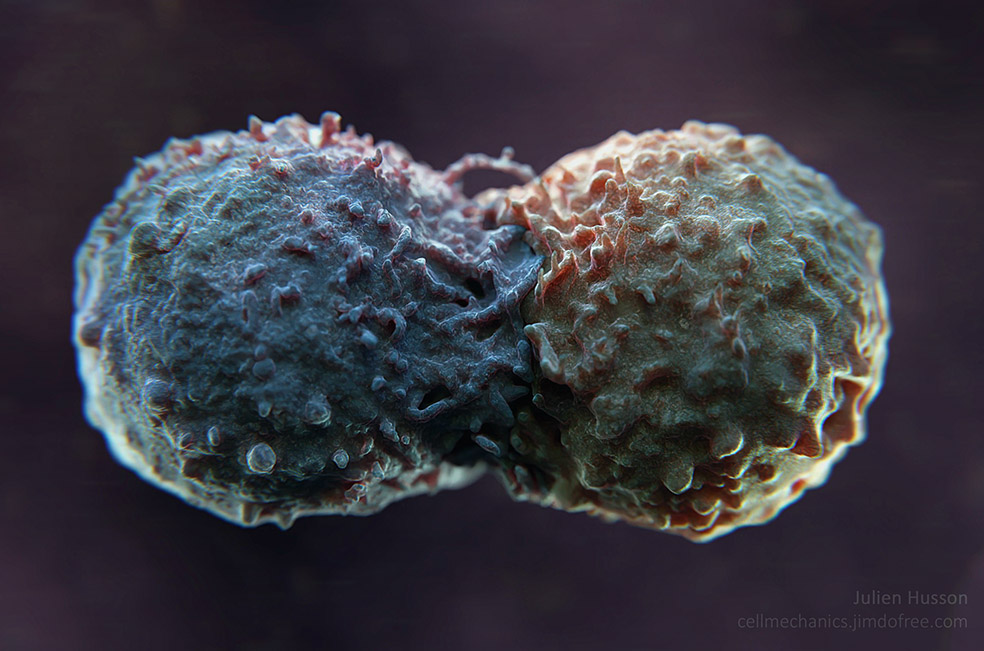
Cell/cell interactions are a paradigm in cell biology since they establish, through biochemical and mechanical contacts, the structures of the living, allowing the cell’s function to take place and potentially synchronise their action. While the biochemical side has been intensively studied, the mechanics, and its articulation with biochemistry, together termed as mechanotransduction, is a current topic of enormous interest.
Immune defense is based on molecular recognition and is classically described with the concepts of specificity, variability and adaptation. This is a prominent example of particular molecular events capable of dictating cell fate and ultimately leading to an adaptative response of the whole organism. These interactions occur between surface attached molecules and may be subjected to mechanical forces. Recently, mechanotransduction has been shown that this concept is highly relevant for immune recognition.
To give one prominent example, we will detail the example of the lymphocytes, a particular subset of white blood cells that is at the core of the immune response. They are cells which live and function as single cells, and do not assemble in a tissue. However, T lymphocytes need to contact antigen presenting cells in a one-to-one manner to allow their efficient activation and subsequent action. Much evidence suggests that the T cell is sensitive to the magnitude as well as the kinetics of force application through its T cell receptors (TCRs), but the link between stimulation and response remains incompletely understood. Moreover, the TCR has been recently shown to act as a mechanosensory molecule. Aside, much evidence is showing that T cells are also sensitive to more global scales of substrate mechanics. As such, T cell activation possess inherently mechanotransduction features at different scales in space and time. The interface formed between a T cell and an antigen presenting cell during immune response, often called the immune synapse, is a prototypical interaction where mechanotransduction is also a key regulating mechanism. The formation of the immune synapse ultimately leads to the production of inflammatory signals and mutual exchange of signals between the cells, as a prelude to the elimination of the pathogenic condition.
Moreover, all of these characteristic have also been recently observed for other immune cells, such as B lymphocytes (for the gathering of antigen by their receptor, named BCR, leading to the production of efficient, high affinity and finely tuned antibodies), macrophages (for the cleaning of parasites),…
As a consequence, mechanotransduction appears to be at the core of many of the essential moments of recognizing and solving of problems by the immune system. The different scales, in time and space, in the molecules and their organization, aside of the variety of immune cell types for which mechanosensing could be crucial, make it a very rich domain which starts to gather researchers from many different fields, from theoreticians to experimentalists, from mathematician to medical doctors. It requires the implication of a large spectrum of fields of physics that may be relevant, eg. statistical physics, non-linear physics, active matter, soft matter…, aside of cell biology / immunology.
However, no comprehensive workshop has been yet organized on this topic, to our knowledge.
Specializeddomains like immunology were often considered in isolation from cell biology and biophysics, with poor sharing of information between the communities. This is beginning to change and our effort is a part of this change. Our ambition is to integrate ideas from cell biology and biophysics, in particular, mechanobiology, into the understanding of immunology at cellular level. This is a timely effort in the international context in view of recent developments dedicated to establishing the fledgling fields of immunophysics and immunoengineering (eg. see some of the c of the last EMBO conference in Sienna “Lymphocyte antigen receptor signalling” in 2018).
It is our ambition to unite, at the national level, (bio)physics and biologists teams who have been addressing similar questions using different tools and approaches. We hope that putting our efforts together can create a synergy that will go far beyond the capabilities of individual teams and help establish a paradigm for research in immunobiophysics. We hope to use this project as the starting point to eventually build a immunobiophysics community in France. Les Houches conference serie will be more than a great context to launch such an initiative.

